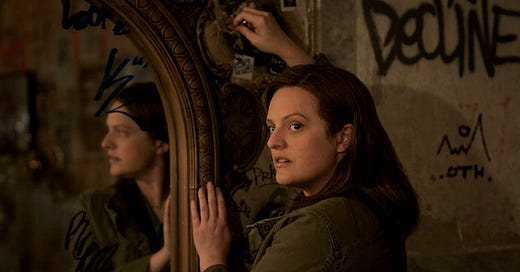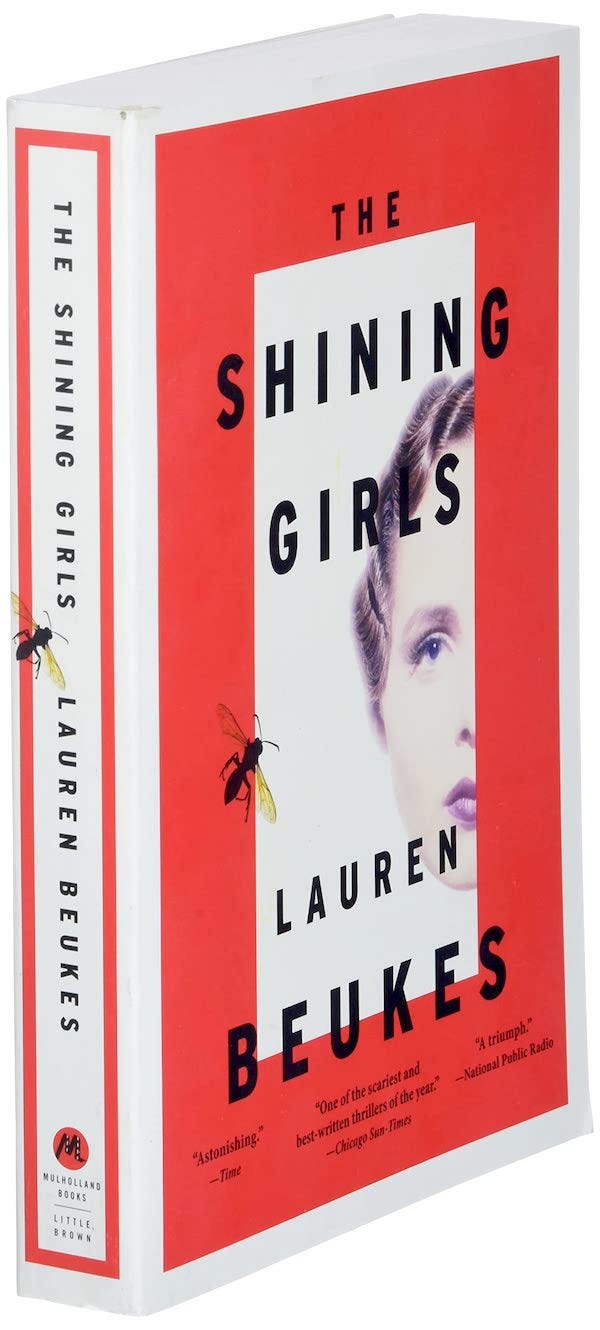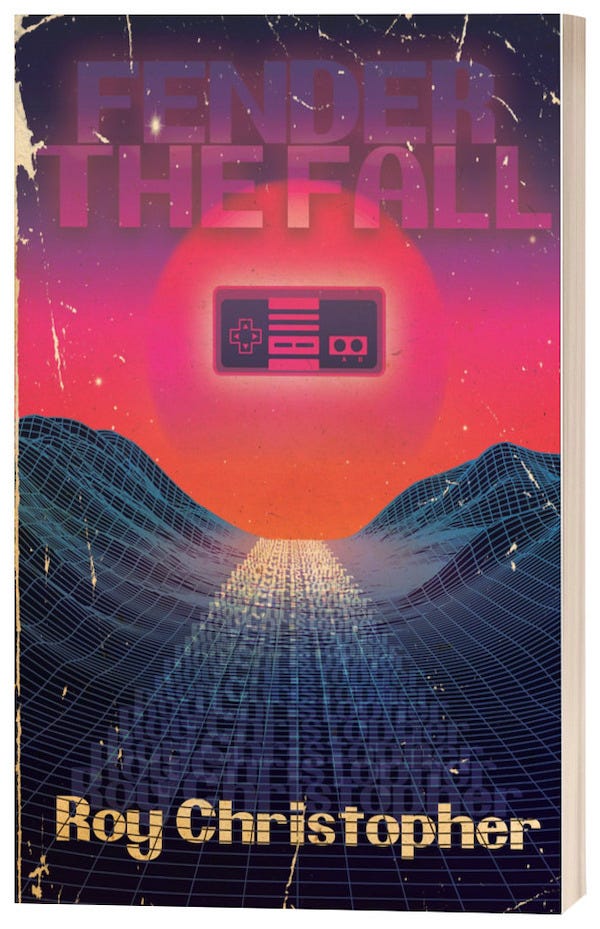Shining Girls' Tangled Timeline of Transgression
“The problem with snapshots,” Kirby Mazrachi thinks, “is that they replace actual memories. You lock down the moment and it becomes all there is of it.” Kirby is one of the girls in The Shining Girls by Lauren Beukes (Mulholland Books, 2013), a disturbingly beguiling novel that is now an Apple TV series in which Elisabeth Moss plays Kirby. Beukes' easily digestible prose and gleefully nagging narrative betray a convoluted timeline and staggering depth of research. Drifter Harper Curtis (played in the show by Jamie Bell) quantum leaps from time to time gutting the girls as he goes. The House he squats in his helper, enabling the temporal jaunts. He’s like an inverted Patrick Bateman: no money, all motive. Where Bateman’s stories are told from his point of view in the tones of torture-porn, Harper’s kills are described from the abject horror of the victims. And the victims, who are all strong-willed women with drive and purpose, are only victims at his hand. Otherwise they shine with potential and promise.
Harper’s havoc reaches roughly from the 1930s to the 1950s and the 1990s. It’s a tangled mess of totems, trauma, and one who got away. As Harper puts it, "There are patterns because we try to find them. A desperate attempt at order because we can’t face the terror that it might all be random." Beukes had her own method, mess, and snapshots to deal with while writing. She had a murderous map, full of "crazy pictures, three different timelines, murder dates…" She told WIRED UK, "It’s been completely insane trying to keep track of all of this."
The Shining Girls is set in my former home of Chicago, which gave me both a history lesson and a feeling of familiarity. The differences among the decades in the story are as interesting as the use of usual local terms like “Red Line,” “Wacker Drive,” “Merchandise Mart,” and “Naked Raygun,” the latter thanks to the one that got away, the spunky, punky Kirby Mazrachi. The book is one part murder mystery, one part detective story, one part science fiction, and another part love story, but it’s all subtle, supple, and masterfully handled.
The Jesus Lizard gets name-dropped in the very first episode of the series. Unlike some of my other favorite books that have made it to the screen in recent years, the Shining Girls adaptation is apt, telling the story in a new way while remaining true to its spirit. Believable time travel is weirdly easier to manage on the page, but the show eases it in, only subtilely hinting at it early on. It's not an overt element of the story until episode six, when we're shown the house's powers full-blown.
1993 is the latest year Harper’s house will go. That’s also the year that Michael Silverblatt of the Los Angeles Times coined the term “transgressive fiction,” a term that aptly describes Beukes’ novel. Silverblatt used the term to describe fiction that includes “unpleasant” content such as sex, drugs, and violence, and coined it in response to the censor-baiting controversy of American Psycho by Bret Easton Ellis (Vintage, 1991), Patrick Bateman’s nearly choked conduit into the world. In Transgressive Fiction: The New Satiric Tradition (Palgrave Macmillan, 2013), Robin Mookerjee discusses Ellis, as well as many other literary forebears of Beukes and The Shining Girls. From mock epics like Ovid’s Metamorphoses and Jonathan Swift’s Gulliver’s Travels to the perversions of J. G. Ballard and Nabokov to the cut-ups and borrowing of William Burroughs and Kathy Acker, on up to contemporary deviants like Chuck Palahniuk, Irvine Welsh, and Ellis, of course. Mookerjee discusses these writers’ novels through the Menippean mode of satire, in which the transgression is total rather than individual, a literary style that “opposes everything and proposes nothing,” as Mookerjee puts it. For instance, in American Psycho, whether Bateman is brushing his teeth or slicing up some hired young thing, his tone never changes. The effect is indirect, general not specific, and pervades the book’s ontology as a whole.
And so it is with the Shining Girls TV show, like its source novel: an eerie portrayal of transgression, trauma, and truth.
You Don’t Know What You’ve Got Until You Get It Back.
My own sci-fi novella, Fender the Fall, is also a time-travel love story. Chris Bridges, a lovelorn physics graduate student who goes back in time to return the journal of his high-school crush in order to save his marriage and her life. The plan doesn’t go as planned.
It’s available from Alien Buddha Press! It’s 5”x8” and 136-pages long, like a good paperback should be. It’s the perfect weekend read.
I was fortunate enough to get Matthew Revert to design the cover and Mike Corrao to do the typesetting. As a result, it’s a sharp-looking little book.
Here’s what other people are saying about it:
“A fun, classic roller-coaster of a time-travel story that could have been published in the 1950s, except that it’s furnished with all manner of savvy insights into current 2020s life.” — Paul Levinson, author of The Plot to Save Socrates
“Fender the Fall is a nostalgia-infused journey through time about second chances and the causality of love. It’s a formative song from your youth revisited, a favorite VHS tape found in the back of your closet.” – Joshua Chaplinsky, author of The Paradox Twins
“Hard-boiled strange loops in a froth of weird.” – Will Wiles, author of Plume
Many thanks to Matt Revert and Mike Corrao for making this thing look so good; Red Focks for putting it out there; Paul Levinson, Josh Chaplinsky, Will Wiles, Jaqi Furback, Gabriel Hart, C.W. Blackwell, Ira Rat, J. Matthew Youngmark, and Jeph Porter for their time, feedback, and kind words; and Claire Putney, from whom I stole the title.
Here’s a soundtrack I put together while writing Fender the Fall. It has songs mostly from and around the years in the story (2002 and 1991).
Order your copy of this lovely, little paperback from Alien Buddha Press now! You won’t regret it.
Thank you for your time and attention, and for reading, responding, and sharing.
More soon,
-royc.
http://roychristopher.com







